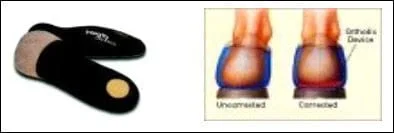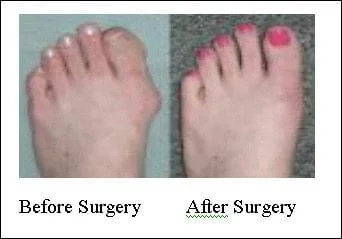Bunions
What is a Bunion?

Bunions are painful swellings that usually develop on the inner side of the foot near the base of the first toe (hallux). Bunions result from abnormal bone formation in the first metatarsalphalangeal joint and misalignment of the first toe.
They can be related to inflammation or to degenerative disease (e.g., osteoarthritis). They cause redness, tenderness, and pain, and alter the normal position of the first toe. "Hallux abducto valgus" (HAV) is a term that refers to the hallux going away (abducting) from the midline of the body and twisting so the inside edge touches the ground and the outside edge turns upward. Essentially, this term describes the deviation of the toe toward the outside of the foot.
Bunions worsen over time and cause discomfort, difficulty walking, and skin problems such as corns and lesions. Sometimes, a small fluid-filled sac (bursa) near the joint becomes inflamed (called bursitis), causing additional swelling, redness, and pain.
What causes a Bunion?
Bunions are one of the most common foot problems. They often run in families, which suggests that the inherited shape of the foot may predispose one to them.
Pronated (flat) feet are unstable and often cause bunions. Body weight is repeatedly transferred to the hallux(big toe) while walking, and in flat feet, this transfer of weight allows certain muscles to become stronger than others. This overpowering of muscles causes the toe to bend and deform.
Bunions may also be caused by tight, pointy-toed, or high-heeled shoes, and shoes that are too small. Women get bunions much more often than men. Improper shoes exacerbate the underlying cause of flat, unstable feet.
Typically, bunions begin as a bump or outward bend of the big toe that is only a cosmetic concern. However, the misaligned, outward-bending toe stretches the ligaments that connect the foot bones and pulls against the tendons, gradually drawing the toe farther out of line. Over time, the big toe continues to twist until it no longer lines up properly with its corresponding metatarsal and the end of the metatarsal may become enlarged. Pressure from the first toe can result in deformity of the metatarsalphalangeal joint in the second toe, pushing it toward the third toe. In some cases, the second toe may ride over or under the big toe. At this point, the range of motion in the big toe is decreased, which is a condition called hallux limitus.
The condition becomes painful at this stage. The bunion changes the shape of the foot and the biomechanics of walking become altered. Normally, the big toe can bend at least 65 degrees, enabling it to be the last part of the foot to leave the ground during walking. However, with hallux limitus, the big toe cannot function properly and the body weight is transferred to the bunion.
Painful bunions cause the patient to compensate by walking in an exaggerated toe-turned-out manner, so the painful hallux does not have to bend as far. Walking with the feet turned out steadily forces the hallux even farther out, worsening the condition. Without treatment, the deformity eventually becomes disabling.
Conservative Treatment
Aims of conservative treatment are mainly to alleviate pressure off the bunion, this may include contrast bath soaks, physical therapy, cortisone injection to reduce the inflammation surrounding the bunion. Wearing wider shoes with increased toe area may also help to take pressure off a painful bunion. Customized functional orthotics are however used more commonly to alleviate pressure off the bunion as well as to reduce progression of the deformity. This process involves a biomechanical exam and casting of the foot but may be the best conservative option available.

Surgical Treatment for Bunions
Bunions worsen over time unless the problem that produces them is eliminated. If a bunion causes severe discomfort, a surgical procedure called a bunionectomy may be performed. Surgical techniques vary, depending on the angle of the bones in the bunion and the extent of the deformity.
The simplest procedure involves shaving the bump and repairing the soft tissue in the big toe joint. Bunions that cause severe discomfort usually require more correction than this procedure provides. In these cases, the most common technique involves surgically cutting and realigning the bones of the big toe. The bones are then repositioned and stabilized with pins, screws, or wires.
Extremely loose or tight ligaments and tendons may also need to be adjusted surgically. Our doctors have mastered the latest techniques including minimally invasive, cosmetic incisions to minimize scar formation. We use internal screws, which can be absorbable so as to get you back in regular shoe gear quicker. Although it depends on the severity of the bunion, most cases involve only having to wear a postoperative stiff soled shoe afterwards for 4-6 weeks, with no crutches. You can ambulate immediately afterwards utilizing the special surgical shoe. Pain is usually very minimal afterwards and most of our patients only usually require a few Tylenol/Advil for several days following the procedure. After surgery and recovery, the patient is fitted with orthotics to maintain stable, properly aligned feet. Without this treatment, the underlying cause of the bunion continues to cause problems and the bunion can recur.


